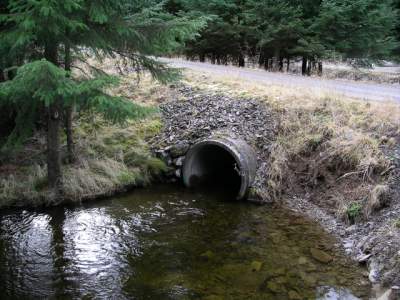What is a Culvert?
Culvert is a tunnel carrying a stream under a road or railway. A culvert may act as a bridge for traffic to pass on it. They are typically found in a natural flow of water and serves the purpose of a bridge or a current flow controller.
Culvert is provided under roads and highways for a crossing of water, as road embankment cannot be allowed to obstruct the water flow. The culvert is ideally suited for a road to limit water flow in a controlled way.
There are some common types of culvert such as pipe, box, and arch culvert. The culvert type is based on hydraulic, water surface elevation, and roadway height and other conditions.

Materials for Culvert Construction
Surrounded by soil, a culvert may be made from a pipe, reinforced concrete or other material. Materials for culvert construction are based on the following materials present below which improves the quality of it.
The selection of material depends on:
- Structure strength
- Hydraulic efficiency
- Installation, local construction practices
- Durability
- Cost
{adselite}
The main materials for culvert construction are:
- Steel
- Structural Steel Plate (SSP)
- Corrugated Steel Pipe (CSP)
- Aluminum pipes
- Concrete
- High - density polyethylene (HDPE)
These main materials are discussed below with their advantages and benefits.
Steel
Steel, that is used in constructing culverts, are mainly Structural Steel Plate (SSP) and Corrugated Steel Pipe (CSP).
Structural Steel Plate (SSP)
Structural Steel Plate, are used to construct arch culverts and metal box culverts. Structural Steel Plate (SSP) provides greater corrosion resistance and are stronger than normal carbon steel. SSP is also very strong and it serves the purpose of building a highly durable culvert. SSP steels meet the requirement to make a good culvert. The SSP specification is intended primarily for use in members, where added durability and strength management is critical.
Corrugated Steel Pipe (CSP)
Corrugated Steel Pipe or Corrugated Metal Pipes (CMP) are used in pipe culverts where the structure of the culvert is round in shape. It is combined with strength and high power. CSP will not break down under the impact of loads due to the strength and the flexibility of the pipe. With a variety of pipe shapes and options, corrugated steel pipe (CSP) products offer users, the greatest flexibility to fit certain requirements.
Aluminum Pipes
Aluminum pipes can be constructed from structural plates or from a single piece of aluminum. Aluminum is mainly used to construct metal box culverts. Aluminum pipes are lightweight and offer good corrosion resistance. The advantages of using aluminum pipes are as follows:
- Lightweight
- Corrosion Resistance
- Ductility
- Recyclability
Concrete
Concrete (reinforced) box culverts are the most common culverts that are found in both rural and urban areas. Concrete pipes used in culvert has a history, an industry that today produces a product for applications. With strength and durability, concrete has the lower environmental impact that provides the following benefits:
- Increased cost savings
- Quicker installation
- Lower environmental impact
High - Density Polyethylene (HDPE)
High - density polyethylene (HDPE) is used for its large ratio of strength and durability. Specific standard and project requirements are engineered for gravity flow systems, which makes HDPE a good material for construction of culverts, especially pipe culverts. High - density polyethylene (HDPE) provides:
- Lightweight yet very strong
- Geater impact resistant
- Long lasting and weather resistant
- Resistance towards insects and great for underground delivery of water
- Easily molded into nearly any shape
The Purpose and Location of Culvert Installation
Culverts must also be properly sized and installed, and protected from erosion and scrub. The purpose of constructing culverts is to prevent flooding and to minimize erosion and to provide pathways for a run-off. So culverts are located under roadway or railway. The culverts should be perpendicular to the roadway. But construction of a separate embankment is not required. The culvert should be located in such a way that flow of water can be done easily. Effective culverts permit water and wildlife to travel without interruption. When culverts are too small or poorly designed, they can interrupt the natural flow of upstream. Culvert failures can occur for a wide variety of reasons including; maintenance, environmental, and installation related failures, functional or process failures related to capacity and volume causing the erosion of the soil around or under them, and structural or material failures that cause culverts to fail due to collapse or corrosion of the materials from which they are made.

